![]() The Pacific War Online Encyclopedia
The Pacific War Online Encyclopedia
|
| Previous: Greenslade, J.W. | Table of Contents | Next: Gridley Class, U.S. Destroyers |
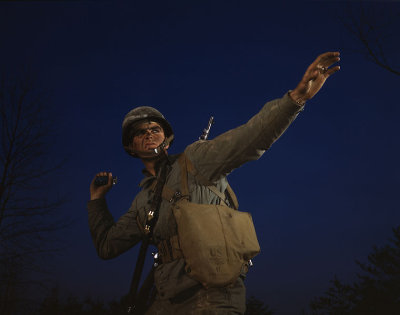
Library of
Congress. Via Wikipedia
Commons.
In addition to their small
arms,
infantry were equipped with
grenades. These were small bombs
with
a 3- to 5-second fuse and were designed to be thrown by hand or
fired
from a rifle using a special blank cartridge.
Hand grenades could be either offensive or defensive. Defensive grenades, such as the American Mark 2 "pineapple," had a heavy metal case designed to break into deadly fragments when the grenade detonated. The lethal radius was greater than the distance the average soldier could throw the grenade, so the thrower had to take cover to avoid being wounded by his own grenade. Offensive grenades had no heavy metal case to produce fragments and relied purely on the blast of the high explosive for their effect. This meant they had a much smaller lethal radius and the thrower did not have to take cover after throwing the grenade. Many offensive grenades could be converted into a defensive grenade using a metal jacket, but these seem not to have seen much use.
In addition to high explosive grenades, the infantry were equipped with smoke grenades to provide cover for movement or to mark enemy positions for heavy weapons or ground support aircraft. Those based on white phosphorus also had some incendiary and antipersonnel capability. There were also incendiary grenades filled with thermite, a mixture of aluminum and iron oxide that burned hotly enough to melt steel. These were used mainly for demolition work.
|
Type 91 grenade |
Type 97 grenade U.S.
Army.
Via Wikipedia
Commons |
The standard Japanese
grenades
were the Type 91 and Type 97 grenades. The Type 91 had a
7.5-second
fuse and adapters to allow it to be used either as a rifle grenade
or
as a projectile for the Type 89 "knee mortar."
Both were filled with two ounces (57 grams) of TNT. The Type 97
had a
4.5 second fuse and was used only as a hand grenade. Both broke
into
very small
fragments that were less lethal and had a much smaller kill radius
than
the corresponding Allied
grenades. Indeed, the grenade was so weak that four of the 27 Marines who were decorated for throwing
themselves on a Japanese grenade survived their acts of heroism.
An example was Corporal Richard Bushman, who was part of a group
of wounded men on Okinawa who
were attacked with a grenade. Bush pulled the grenade to himself
to save the others but, while severely wounded, survived.
The fuse was rather unusual, being lit by banging the grenade on any solid surface to drive a firing pin into an igniter. The fuse was also unreliable if stored for any length of time, tending to go off too quickly. The Japanese apparently planned to replace these rather dangerous and ineffective grenades with a model that used a friction igniter. However, few of these grenades were ever manufactured and their effectiveness is unknown.
The Japanese also employed a stick grenade resembling the German "potato-masher," which used a 4.5-second friction fuse and was filled with three ounces (85 grams) of picric acid. This was declared obsolete before war broke out, but existing stocks were used throughout the war in spite of erratic fuses that sometimes detonated the grenade almost immediately.
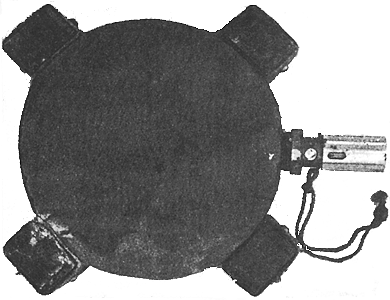
U.S. Army. Via
ibiblio.org
The Type 99 Hakobakurai was a 5" (12cm) disk of TNT in a canvas container with four magnets and a four-second fuse. It was designed to be thrown against a tank after being armed, but the magnets proved too weak to reliably hold the charge onto the side of the tank. Japanese soldiers overcame this difficulty by holding the charge in place by hand, destroying themselves and hopefully the tank.
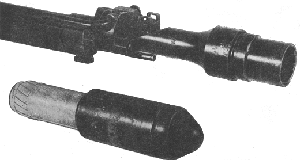
Type 2 40mm Hollow Charge Rifle Grenade
U.S. Army. Via ibiblio.org
The Type 3 Conical Hand-Thrown Mine was a shaped charge grenade with a hemp tail that provided crude guidance when the grenade was thrown against a tank. It proved largely ineffective. The Type 2 40mm Hollow Charge Rifle Grenade was somewhat more effective, particularly when it was fired against the thin rear armor of a tank.
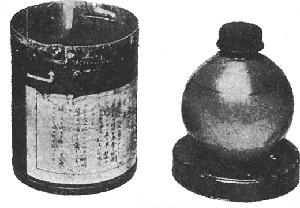
U.S. Army. Via ibiblio.org
The Frangible Smoke Grenade was a glass sphere filled with
volatile
titanium tetrachloride. When the grenade broke, the titanium
tetrachloride promptly combined with moisture in the air to
produce a
noxious cloud of titanium dioxide and hydrogen chloride. This
created a
smoke screen that blinded tank crews and allowed Japanese infantry
to
attack the tanks with satchel charges. This grenade saw use on Okinawa, where it usually
forced
American tanks to retreat or be destroyed.
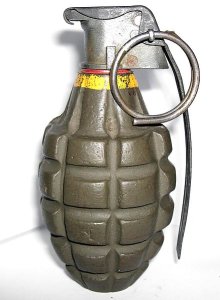
J.L.Dubois. Via Wikipedia Commons
The standard U.S. grenade was the MIIA1 fragmentation grenade, a
defensive grenade filled with 0.75 ounces (21 grams) of EC
gunpowder. This
seemingly weak fill was actually quite effective, since the slower
explosion improved the fragmentation. The lethal radius of the
fragments was estimated as 30 yards, though some fragments flew as
far
as 200 yards. Because no detonator was
required, the fuse design was simple. Fuse duration was 4 or 4.5
seconds. Soldiers were trained
to throw the grenade like an American football, with the fuse to
the
rear and the grenade given a slight spin. An adapter was also
supplied
that
allowed the MIIA1 to be used as a rifle grenade. Unfortunately,
grenades stockpiled before the war were notoriously unreliable,
often
failing to go off.
The Mark IIIA2 was an offensive grenade consisting of a fairly
large
charge of TNT (6.25 ounces or 177 grams) in a cardboard cylinder
with a
4.5-second fuse. The effective radius of its concussion was
estimated
as just 7 yards. Though intended primarily for demolition
work, the grenade saw extensive use for clearing houses and bunkers in
the Pacific, as at Makin,
where it was found that even those offensive grenades which fell
short
of their targets kicked up a concealing cloud of dust that helped
cover
the advance.
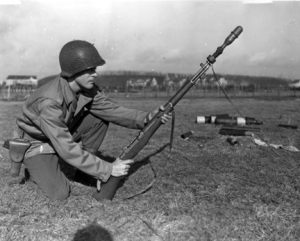
The M9 anti-tank rifle grenade had a four ounce (113 gram) shaped charge of Pentolite that could penetrate 40mm of armor. It was very quickly replaced by the M9A1, which moved the fuse from the nose to the rear of the grenade where it would not interfere with the jet, improving the penetration to 60mm. This was enough to penetrate the rather thin armor on most Japanese tanks. Effective range was estimated at 75 yards. At the start of the war, each infantry squad included an antitank rifle grenadier equipped with a Springfield 1901 bolt-action rifle for firing rifle grenades. However, the grenade seems to have seen little use, perhaps because of the superiority of the bazooka in the antitank role.
The M15 was a white phosphorus grenade with a 4.5-second fuse. On detonation, it scattered the phosphorus over an area 25 yards (23 meters) in diameter, and the phosphorus burned for over 30 seconds. This grenade was widely employed as an anti-personnel grenade in the Pacific. The M8 used hexachloroethane to produce white smoke, while the M16 and M18 produced colored smoke for target designation. The M8 smoked for three minutes, the M16 for 2 minutes 15 seconds, and the M18 for one minute. The M3 came only in a red smoke version but put out a greater volume of smoke, lasting about 2 minutes and 20 seconds.
Troops on Leyte complained that the M8 was unreliable and much preferred the M15. One wonders to what extent this actually reflected the reliability of the M8 and how much reflected a preference for a smoke grenade that also had significant antipersonnel and incendiary value.
The M14 was a thermite grenade used to burn out strong points or
demolish equipment. It was equipped with a 2-second fuse and
burned for over 30 seconds.
The standard British
grenade was the Number 36M Mills grenade, a defensive grenade
which was
filled with 2.5 ounces (71 grams) of Baratol. By the time of the
Pacific War, the original 7-second fuse had been replaced with a
4-second fuse. Because the detonator was not centered in the
grenade,
the explosion was asymmetric and fragmentation was erratic. Large
fragments could be thrown up to 100 yards, making it vital for the
thrower to take cover. However, the grenade was powerful and very
reliable. Various attempts to improve the design failed, and the
grenade remained in use for decades after the war ended. It could
be
fitted with a tail rod for use as a rifle grenade, and this
version
retained the 7-second fuse.
The Number 68 antitank rifle grenade was filled with 5.5 ounces (156 grams) of explosive (Pentolite, Lyddite, or RDX) and exploded on impact. It was the first shaped-charge antitank weapon to enter service with any nation, and it was capable of penetrating 50mm of armor. However, it is unclear whether this grenade was issued to forces fighting against the Japanese. At one point a rather strange suggestion was made to fire the grenade from a crossbow for stealth (The King's Own Wookiee Grenadiers?) This idea was quickly dropped.
The British offensive grenade was the Type 69, which with 3.25 ounces (92 grams) of explosive in a plastic case was not expected to kill so much as to shock. However, it was far from nonlethal, and there were a number of serious training accidents before this point was driven home. The grenade used an "all-ways" impact fuse that was primed when a weight pulled the pin after the grenade was pulled. This fuse contained a lead ball which, once it was armed, would detonate the grenade any way it landed. A cast iron jacket was issued to convert the grenade to a defensive grenade if needed, but this was sufficiently clumsy and inferior to a real defensive grenade that it was seldom used.
Early in 1945, 14 Army in Burma was equipped with small numbers of the experimental Number 70 grenade. This was an attempt to improve on the Mills grenade by improving the fragmentation and using an "all-ways" impact fuse. The fuse proved unreliable and the troops preferred the familiar Mills.
The Number 80 grenade contained 11.25 ounce (319 gram) white
phosphorus and had a 2.5- to 4-second fuse. Its small explosive
charge
dispersed the phosphorus over a radius of about ten yards (nine
meters)
to produce an instant smoke screen. It also had some value as an
incendiary and antipersonnel grenade.
The Number 85 antitank rifle grenade had a 4.25 ounce (120 gram)
shaped charge and was similar to the U.S. M9A1 rifle grenade. It
saw
use only in the closing stages of the war in the Far East.
A number of other specialized grenades, some of which were downright odd (such as the Number 74 sticky bomb and the Number 82 gammon grenade), were also part of the British arsenal. The sticky bomb was an explosive charge with a sticky treacle coating that allowed it to stick to the hull of an enemy tank. Some sticky bombs were shipped to New Guinea, where they proved useless because the treacle coating rapidly became moldy. It is unlikely that any of the others saw much use in the Far East.
References
Cannon (1953;
accessed 2013-1-16)
FM-7-10-1 (1941-6-2; accessed 2013-1-16)
FM-23-30
(; accessed 2013-1-16)
Gilbert
(2001)
"The
Capture of Makin" (accessed 2013-1-16)
The Pacific War Online Encyclopedia © 2007-2010, 2013 by Kent G. Budge. Index